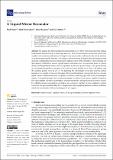| dc.contributor.author | Haber, Elad | |
| dc.contributor.author | Douvidzon, Mark | |
| dc.contributor.author | Maayani, Shai | |
| dc.contributor.author | Carmon, Tal | |
| dc.date.accessioned | 2023-03-10T18:38:19Z | |
| dc.date.available | 2023-03-10T18:38:19Z | |
| dc.date.issued | 2023-03-08 | |
| dc.identifier.uri | https://hdl.handle.net/1721.1/148473 | |
| dc.description.abstract | We present the first experimental demonstration of a Fabry‒Perot resonator that utilizes total internal reflection from a liquid–gas interface. Our hybrid resonator hosts both optical and capillary waves that mutually interact. Except for the almost perfect reflection by the oil–air interface at incident angles smaller than the critical angle, reflections from the liquid-phase boundary permit optically examining thermal fluctuations and capillary waves at the oil surface. Characterizing our optocapillary Fabry‒Perot reveals optical modes with transverse cross-sectional areas of various shapes and longitudinal modes that are separated by the free spectral range. The optical finesse of our hybrid optocapillary resonator is Fo = 60, the optical quality factor is Qo = 20 million, and the capillary quality factor is Qc = 6. By adjusting the wavelength of our laser near the optical resonance wavelength, we measure the liquid’s Brownian fluctuations. As expected, the low-viscosity liquid exhibits a distinct frequency of capillary oscillation, indicating operation in the underdamped regime. Conversely, going to the overdamped regime reveals no such distinct capillary frequency. Our optocapillary resonator might impact fundamental studies and applications in surface science by enabling optical interrogation, excitation, and cooling of capillary waves residing in a plane. Moreover, our optocapillary Fabry‒Perot might permit photographing thermal capillary oscillation, which the current state-of-the-art techniques do not support. | en_US |
| dc.publisher | Multidisciplinary Digital Publishing Institute | en_US |
| dc.relation.isversionof | http://dx.doi.org/10.3390/mi14030624 | en_US |
| dc.rights | Creative Commons Attribution | en_US |
| dc.rights.uri | https://creativecommons.org/licenses/by/4.0/ | en_US |
| dc.source | Multidisciplinary Digital Publishing Institute | en_US |
| dc.title | A Liquid Mirror Resonator | en_US |
| dc.type | Article | en_US |
| dc.identifier.citation | Micromachines 14 (3): 624 (2023) | en_US |
| dc.contributor.department | Massachusetts Institute of Technology. Research Laboratory of Electronics | |
| dc.identifier.mitlicense | PUBLISHER_CC | |
| dc.eprint.version | Final published version | en_US |
| dc.type.uri | http://purl.org/eprint/type/JournalArticle | en_US |
| eprint.status | http://purl.org/eprint/status/PeerReviewed | en_US |
| dc.date.updated | 2023-03-10T14:02:09Z | |
| dspace.date.submission | 2023-03-10T14:02:09Z | |
| mit.license | PUBLISHER_CC | |
| mit.metadata.status | Authority Work and Publication Information Needed | en_US |
